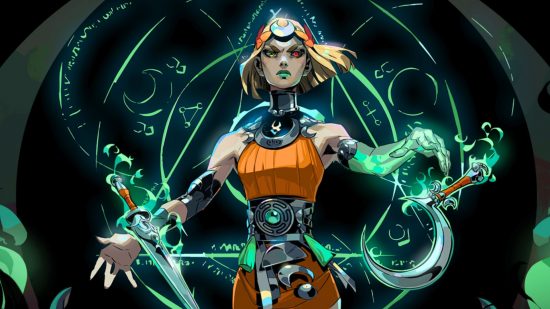I’ll be the first to admit that my excitement around the announcement of Hades 2, the direct sequel to one of my favorite games of all time, was pierced with apprehension. Supergiant’s approach to sequels in the past has been to, well, not make them. Each new game the indie studio puts out features a new world with new characters, challenges, narratives, and gameplay styles. Hades hit differently, though, with its roguelike structure embellished with tales of mythological family and personal struggles. The element of the original Hades that really drew me in, as a queer woman, was the underlying theme of sexuality and gender identity that highlighted the personal lifestyles of us all.
Hades’ protagonist, Zagreus, is bisexual, but you’ll only discover that by paying attention throughout the roguelike game to flirty comments from Aphrodite or listening intently to Zag’s conversations with Megaera – or providing multiple gifts of nectar to Thanatos. The beloved yet chaotic Dusa responds to Zagreus’ queries around why she no longer has a body, instead presenting as a floating head, by saying this is just the way she is, and that her history is private. When he apologizes, she tells him how she didn’t feel “connected” to the body she used to have, and feels more like herself in her current state, something that resonated with trans fans and players. In my mind, improving on the narrative, combat, and deep personal connection I felt to Hades was near impossible for Hades 2 to achieve.
Enter Melinoë, Zagreus’ sister, the protagonist of Hades 2, the Princess of the Underworld, and bisexual with the love interests of Nemesis and Moros. As someone who’s experienced having her bisexuality invalidated, on the basis that I don’t ‘pick a side,’ this inclusivity and recognition means Hades strikes a chord with me that no other series has, and normalizes those personal identities. There’s even a little frog, Frinos, to confide in. Every bisexual knows the frogs are our icons.

As the Greek goddess of revenge, Nemesis appears in the game for painfully obvious reasons, and it’s no surprise that Melinoë finds herself drawn to her. After all, you might say she has a score or two to settle. Moros, if you play the technical test for as long as I did, appears as an unknown figure to begin with, but Melinoë soon recognizes him as the Emissary of the Three Fates, or Doom Incarnate. With such a cocktail of turbulent relationships to untangle, Hades 2 is already shaping up to be a worthy successor.
It’s not just these deep interpersonal relationships, tales of revenge, and intricate sexual and romantic implications that Hades 2 is already succeeding at, though. After spending perhaps a few too many hours in the technical test, I’ve begun to recognize elements of the original that captured my attention and in turn my heart, only they’ve now been embellished, emboldened, and exaggerated.
Systems such as the prophecy scripts, which task you with mini quests that have small material rewards, now appear after several hours rather than at the game’s outset, giving a feeling of an elongated experience. Gifting nectar to the various Hades 2 gods and characters will now grant new, more rewarding keepsakes that strongly affect your build each time you head into Erebus.
The premise is the same as the first game; head out on a run, select different boons and rewards for each room you enter, face off against a series of enemies and minibosses before eventually coming face to face with that area’s boss. The technical test is limited to the area of Erebus, which culminates in a battle against Hecate, Melinoë’s headmistress and trainer, which tests every decision you’ve made in the lead-up to it.
In Hades 2, though, the experience is extended and elaborated upon with the inclusion of new systems, like Reagents, Greeneries, Incantations and Arcana cards. The inclusion of witchcraft in Hades 2 is a deliberate one, as Supergiant explains that it’s integral to numerous Greek myths.
Hecate herself is a secretive goddess of witchcraft and the Crossroads, an area represented in the game by physical crossroads, but which also serves as one of the portal areas of the game where upgrades can be bought, recipes can be brewed, plants can be grown, and of course there are pets to hand treats to. Hecate is a hugely influential and deeply compelling character in Greek mythology, and looks to be just as vital to the retelling of Melinoë’s story throughout Hades 2.
Gathering tools have been introduced, which are so far limited to the Silver Spade, Crescent Pick, and Tablet of Peace, which allow you to dig for seeds, harvest Silver, and compel Lone Shades to the Crossroads in exchange for Psyche. Psyche is used in the Arcana Cards system, and Silver can be used to unlock new weapons.
The systems are certainly more complex, but never confusingly so, and the helpful Forget-Me-Not ability allows you to pin recipes you’d like to remember, with a symbol above the ingredients’ locations throughout Erebus, so you can recall which items you’d planned to track down among the chaos of a Hades 2 run.
Combat feels as smooth and satisfying as ever, although it still presents a challenge. It took me three attempts to best Hecate, after which I was told I’d only be allowed five successful boss fights against her before the technical test would be complete for me. With an immense fear of that happening and having to wait for the Hades 2 release date, I’ve decided to spend more time wandering Erebus. As the series that taught me it’s okay to fail, I’ll relish every time I view the screen that exclaims, ‘Time cannot be stopped,’ upon my death in Hades 2, because it means one more run is right around the corner.





